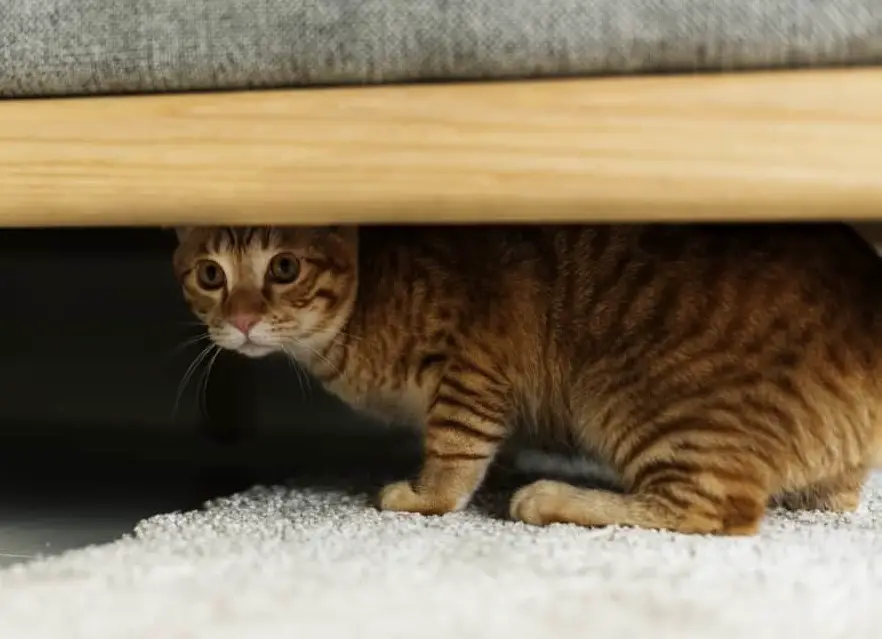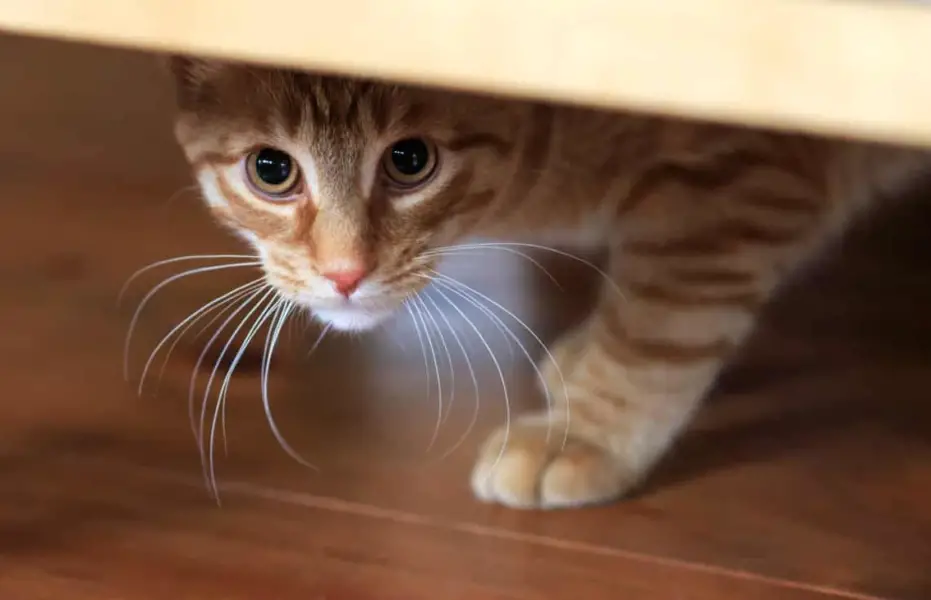Fear Free Isn’t Only Reserved for Vet Visits, It Applies to Your Cat’s Daily Life. Here’s how:
Doing your best to remove fear from vet visits is really important for you and your cat. And removing fear from your cat’s everyday life can help improve the quality of life they experience and lead to a much happier cat and a really great bond between human and animal.
Owners who dread taking their cat to the vet because of the intense fear the cat exhibits often prevents cats from receiving the care and treatment they need and deserve. It’s exciting that veterinarians are now rallying around our cats to create fear-free environments in the vet office to make you and your cat more comfortable.
I had the pleasure of interviewing Steve Dale, Certified Animal Behavior Consultant, about the fear-free movement for cats. Steve is an ambassador for the fear-free movement and is speaking about it at Meow MeetUp Chicago on July 21.
Check out our interview with Steve Dale!
The Beginnings of the Fear-Free Movement
The fear free movement originated with Dr. Marty Becker. According to Dale, Dr. Becker had an epiphany about vet visits and thought there was a better way to address both the physical and mental health of cats and ran that idea past him. There had to be a way to minimize the fear and stress that cats feel which is triggered by vet visits. He decided then that the mental health of cats needed to be addressed. Dr. Becker rallied a legion of experts including Steve Dale to embrace this movement which caught on very quickly “because the timing was right and it was the right thing to do,” says Dale.
Where does fear-free start?
Fear-free begins in the home. Sadly many pets live in constant fear – both cats and dogs. It’s not uncommon to see dogs that have fear – like thunderstorm anxiety, but fear is worse in cats. Says Dale, “People need to realize that it is not normal for your cat to hide under the bed or in your closet when someone comes over.” This behavior shows a lack of confidence and fear. “Many cat owners don’t even realize that their cat is living in fear, and there’s an unfortunate domino effect that goes on.” Studies have shown that fearful cats are more likely to have various health issues including idiopathic feline lower urinary tract disease (FLUTD) or Pandora’s Syndrome. Then they start to miss or avoid the litter box. “When that happens, the cat is sadly booted outside or relinquished to a shelter and the human-cat bond breaks.”

Now is the Time for Fear-Free
Cats don’t have to live in fear. The knowledge we have today is much better than what we had 10-15 years ago. “We are in a much better place today than ever to deal with fear in cats. Today we know about pheromones, supplements, pharmaceuticals and how important it is that our cats are provided enriched environments,” remarks Dale.
The Mind of the Cat – What They’re Thinking
When your cat is in the midst of fear, they are panicked and “to be frank, your cat thinks it’s going to die,” says Dale. “They don’t understand what is happening. All they know is that their best friend (you) is trying to kill them.” When confronted with a visit to the veterinarian, your cat is probably confused as to why their best friend (you) is chasing them around the house and suddenly trying to stuff them into a carrier and then tossing them into the car. When they get to the vet, they’re confronted with a strange place with even stranger smells. “And the smell can remind them of a previous unpleasant experience at the vet office. And on and on. They’re petrified!” says Dale.
How Can Cat Owners Relieve Fear?
Steve recommends starting as early as possible – when your cat is kitten. He recommends leaving your cat’s carrier out and allowing your cat sleep in it from the time they’re babies. “Your cat will then associate the carrier as a safe place,” says Dale. Next, he recommends taking neutral drives in the car when nothing bad happens. “Make it a happy experience by starting out with very short drives and then increase the length.” Steve noted that pet parents can go to the vet and not have a visit just to practice and get your cat used to going there without anything bad happening. “Let your cat sniff around and then go home.” Interestingly, many vets (especially fear-free certified vets) will allow you to come over and help your pet get acclimated.
How Do You Relieve Fear If Your Cat is Older?
Steve notes that it’s a similar process but that you’ll need to go very slowly. He recommends starting by leaving the carrier out all the time – like you would do with a kitten. But then you need to desensitize your cat by adding food and/or treats near their carrier. Your cat will notice that food and treats “randomly” appear there and they’ll start to associate happy feelings with the carrier. Says Dale “You can follow much of the same processes as kittens by taking your cat for short rides in the car that don’t result in a vet visit. Keep rides very short and positive.”
Next, load your cat into the carrier and carry the cat around the house and then let the cat out nonchalantly and give them treats or a meal so they associate good things with the carrier.
Once your cat has that mastered, go for a quick ride around the block and then come home. Continually reward your cat with treats to reinforce the positive experience. Eventually you can take your cat to the vet clinic for a “mock” vet visit where nothing happens – they just visit and come home. “When you’re ready to go to the vet for a real visit, spray the carrier with Feliway or use a Feliway wipe about 15 minutes before you go. Bring treats with you to the vet and have the exam and then go home,” says Dale.
If You Tried Everything and Things Seem Hopeless…
If your cat is absolutely petrified, Steve recommends that you talk to your vet about it. “Your vet can offer psycho-pharmacological help or a nutritional supplement to help alleviate your cat’s stress. While some people might not want to give their cat a prescription, I would argue that it’s much more humane to give your cat something that will help them cope than to have them literally thinking that they are about to die,” says Dale. Taking your cat to the vet is good pet parenting. Everyone knows that it’s much better to catch an illness or disease early to offer the best outcomes. Therefore avoiding the vet is not helpful to your cat and can actually reduce their lifespan.
Find a Fear-Free Vet
Every vet is different, so be assertive and ask your vet what options they offer to make visits fear free for your cat. Many owners aren’t seeking help before the visit and they should know that help is available. Steve noted a variety of tactics that some veterinarians are doing and/or offering to help cats cope including:
- Having a separate waiting area for cats that are “dog-free” zones
- Allowing you to wait in the car with your cat until the vet is ready to see you (they can call you on your cell phone to let you know they’re ready for you)
- Allowing you to enter through a different door and going directly into the exam room
- Dedicating exam rooms to cats only and spraying with Feliway to help reduce the stress of smelling dogs and other pheromones
Talking to your vet is the only way to know what they offer and what they can do to help ease your cat’s fear.
Some Fear Is Normal. But How Much?
Some fear is normal – such as when a stranger comes over. But “what’s most important is that your cat recovers quickly,” remarks Dale. “If your cat is not quickly rebounding from this incident, you should think about how you can help build your cat’s confidence.”
Helping Your Cat Live Fear-Free Every Day
Steve offered a variety of ideas that cat owners can consider to help their cats and build confidence such as:
- Using Feliway diffusers – which contain feline pheromones that can help your cat feel at ease.
- Providing your cat with an escape room or escape route where he/she can get away from something that is stressing them out. If you don’t have a separate room, get a great cat tree or a cat cave if your cat prefers to be on the ground.
- Instructing people who visit your home to never interact with your cat unless your cat makes the first move.
- Having your guests gently toss a few treats to your cat if your cat is in the room when company is over, but seems timid or fearful. You can make it a game – just don’t overdo it.
- Taking an interactive cat toy, like a wand toy, and engaging the cat for a minute or two if your cat seems more curious and less fearful. In time, the cat may eventually come out – but make sure that coming out is your cat’s choice. Never force your cat.
Our biggest takeaway is that fear-free isn’t just about vet visits, but it’s about what cat owners can do in their cat’s every day life to make their lives happy and stress-free. We’d like to offer a hearty “thank you” to Steve Dale for an incredibly informative interview!
Want to learn more? Check out fearfreehappyhomes.com and stevedale.tv. And if you’re near the Chicagoland area July 20-21, be sure to come out to the big Meow MeetUp by The Catnip Times at the Donald E Stephens Convention Center!
